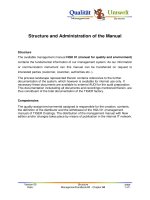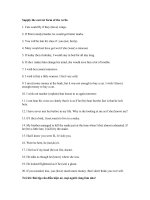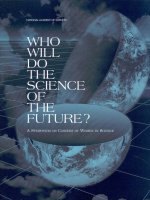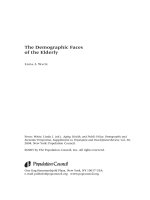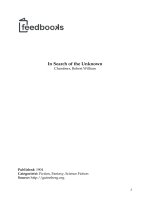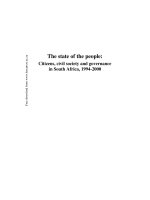MOLECULAR IMAGING OF THE LUNGS docx
Bạn đang xem bản rút gọn của tài liệu. Xem và tải ngay bản đầy đủ của tài liệu tại đây (13.3 MB, 508 trang )
MOLECULAR IMAGING
OF THE LUNGS
DK5682_half-series-title.qxd 3/24/05 10:19 AM Page A
LUNG BIOLOGY IN HEALTH AND DISEASE
Executive Editor
Claude Lenfant
Former Director, National Heart, Lung, and Blood Institute
National Institutes of Health
Bethesda, Maryland
1. Immunologic and Infectious Reactions in the Lung,
edited by C. H. Kirkpatrick and H. Y. Reynolds
2. The Biochemical Basis of Pulmonary Function, edited by
R. G. Crystal
3. Bioengineering Aspects of the Lung, edited by J. B. West
4. Metabolic Functions of the Lung, edited by Y. S. Bakhle
and J. R. Vane
5. Respiratory Defense Mechanisms (in two parts), edited by
J. D. Brain, D. F. Proctor, and L. M. Reid
6. Development of the Lung, edited by W. A. Hodson
7. Lung Water and Solute Exchange, edited by N. C. Staub
8. Extrapulmonary Manifestations of Respiratory Disease,
edited by E. D. Robin
9. Chronic Obstructive Pulmonary Disease, edited by T. L. Petty
10. Pathogenesis and Therapy of Lung Cancer, edited by
C. C. Harris
11. Genetic Determinants of Pulmonary Disease, edited by
S. D. Litwin
12. The Lung in the Transition Between Health and Disease,
edited by P. T. Macklem and S. Permutt
13. Evolution of Respiratory Processes: A Comparative Approach,
edited by S. C. Wood and C. Lenfant
14. Pulmonary Vascular Diseases, edited by K. M. Moser
15. Physiology and Pharmacology of the Airways, edited by
J. A. Nadel
16. Diagnostic Techniques in Pulmonary Disease (in two parts),
edited by M. A. Sackner
17. Regulation of Breathing (in two parts), edited by T. F. Hornbein
18. Occupational Lung Diseases: Research Approaches
and Methods, edited by H. Weill and M. Turner-Warwick
19. Immunopharmacology of the Lung, edited by H. H. Newball
20. Sarcoidosis and Other Granulomatous Diseases of the Lung,
edited by B. L. Fanburg
DK5682_half-series-title.qxd 3/24/05 10:19 AM Page B
21. Sleep and Breathing, edited by N. A. Saunders
and C. E. Sullivan
22. Pneumocystis carinii Pneumonia: Pathogenesis, Diagnosis,
and Treatment, edited by L. S. Young
23. Pulmonary Nuclear Medicine: Techniques in Diagnosis of
Lung Disease, edited by H. L. Atkins
24. Acute Respiratory Failure, edited by W. M. Zapol
and K. J. Falke
25. Gas Mixing and Distribution in the Lung, edited by L. A. Engel
and M. Paiva
26. High-Frequency Ventilation in Intensive Care and During
Surgery, edited by G. Carlon and W. S. Howland
27. Pulmonary Development: Transition from Intrauterine to
Extrauterine Life, edited by G. H. Nelson
28. Chronic Obstructive Pulmonary Disease: Second Edition,
edited by T. L. Petty
29. The Thorax (in two parts), edited by C. Roussos
and P. T. Macklem
30. The Pleura in Health and Disease, edited by J. Chrétien,
J. Bignon, and A. Hirsch
31. Drug Therapy for Asthma: Research and Clinical Practice,
edited by J. W. Jenne and S. Murphy
32. Pulmonary Endothelium in Health and Disease, edited by
U. S. Ryan
33. The Airways: Neural Control in Health and Disease,
edited by M. A. Kaliner and P. J. Barnes
34. Pathophysiology and Treatment of Inhalation Injuries,
edited by J. Loke
35. Respiratory Function of the Upper Airway, edited by
O. P. Mathew and G. Sant’Ambrogio
36. Chronic Obstructive Pulmonary Disease: A Behavioral
Perspective, edited by A. J. McSweeny and I. Grant
37. Biology of Lung Cancer: Diagnosis and Treatment, edited by
S. T. Rosen, J. L. Mulshine, F. Cuttitta, and P. G. Abrams
38. Pulmonary Vascular Physiology and Pathophysiology,
edited by E. K. Weir and J. T. Reeves
39. Comparative Pulmonary Physiology: Current Concepts,
edited by S. C. Wood
40. Respiratory Physiology: An Analytical Approach,
edited by H. K. Chang and M. Paiva
41. Lung Cell Biology, edited by D. Massaro
42. Heart–Lung Interactions in Health and Disease,
edited by S. M. Scharf and S. S. Cassidy
43. Clinical Epidemiology of Chronic Obstructive Pulmonary
Disease, edited by M. J. Hensley and N. A. Saunders
DK5682_half-series-title.qxd 3/24/05 10:19 AM Page C
44. Surgical Pathology of Lung Neoplasms, edited by
A. M. Marchevsky
45. The Lung in Rheumatic Diseases, edited by G. W. Cannon
and G. A. Zimmerman
46. Diagnostic Imaging of the Lung, edited by C. E. Putman
47. Models of Lung Disease: Microscopy and Structural Methods,
edited by J. Gil
48. Electron Microscopy of the Lung, edited by D. E. Schraufnagel
49. Asthma: Its Pathology and Treatment, edited by M. A. Kaliner,
P. J. Barnes, and C. G. A. Persson
50. Acute Respiratory Failure: Second Edition, edited by
W. M. Zapol and F. Lemaire
51. Lung Disease in the Tropics, edited by O. P. Sharma
52. Exercise: Pulmonary Physiology and Pathophysiology,
edited by B. J. Whipp and K. Wasserman
53. Developmental Neurobiology of Breathing, edited by
G. G. Haddad and J. P. Farber
54. Mediators of Pulmonary Inflammation, edited by M. A. Bray
and W. H. Anderson
55. The Airway Epithelium, edited by S. G. Farmer and D. Hay
56. Physiological Adaptations in Vertebrates: Respiration,
Circulation, and Metabolism, edited by S. C. Wood,
R. E. Weber, A. R. Hargens, and R. W. Millard
57. The Bronchial Circulation, edited by J. Butler
58. Lung Cancer Differentiation: Implications for Diagnosis
and Treatment, edited by S. D. Bernal and P. J. Hesketh
59. Pulmonary Complications of Systemic Disease, edited by
J. F. Murray
60. Lung Vascular Injury: Molecular and Cellular Response,
edited by A. Johnson and T. J. Ferro
61. Cytokines of the Lung, edited by J. Kelley
62. The Mast Cell in Health and Disease, edited by M. A. Kaliner
and D. D. Metcalfe
63. Pulmonary Disease in the Elderly Patient, edited by
D. A. Mahler
64. Cystic Fibrosis, edited by P. B. Davis
65. Signal Transduction in Lung Cells, edited by J. S. Brody,
D. M. Center, and V. A. Tkachuk
66. Tuberculosis: A Comprehensive International Approach,
edited by L. B. Reichman and E. S. Hershfield
67. Pharmacology of the Respiratory Tract: Experimental
and Clinical Research, edited by K. F. Chung and P. J. Barnes
68. Prevention of Respiratory Diseases, edited by A. Hirsch,
M. Goldberg, J P. Martin, and R. Masse
DK5682_half-series-title.qxd 3/24/05 10:19 AM Page D
69. Pneumocystis carinii Pneumonia: Second Edition, edited by
P. D. Walzer
70. Fluid and Solute Transport in the Airspaces of the Lungs,
edited by R. M. Effros and H. K. Chang
71. Sleep and Breathing: Second Edition, edited by
N. A. Saunders and C. E. Sullivan
72. Airway Secretion: Physiological Bases for the Control
of Mucous Hypersecretion, edited by T. Takishima
and S. Shimura
73. Sarcoidosis and Other Granulomatous Disorders, edited by
D. G. James
74. Epidemiology of Lung Cancer, edited by J. M. Samet
75. Pulmonary Embolism, edited by M. Morpurgo
76. Sports and Exercise Medicine, edited by S. C. Wood
and R. C. Roach
77. Endotoxin and the Lungs, edited by K. L. Brigham
78. The Mesothelial Cell and Mesothelioma, edited by
M C. Jaurand and J. Bignon
79. Regulation of Breathing: Second Edition, edited by
J. A. Dempsey and A. I. Pack
80. Pulmonary Fibrosis, edited by S. Hin. Phan and R. S. Thrall
81. Long-Term Oxygen Therapy: Scientific Basis and Clinical
Application, edited by W. J. O’Donohue, Jr.
82. Ventral Brainstem Mechanisms and Control of Respiration
and Blood Pressure, edited by C. O. Trouth, R. M. Millis,
H. F. Kiwull-Schöne, and M. E. Schläfke
83. A History of Breathing Physiology, edited by D. F. Proctor
84. Surfactant Therapy for Lung Disease, edited by B. Robertson
and H. W. Taeusch
85. The Thorax: Second Edition, Revised and Expanded (in three
parts), edited by C. Roussos
86. Severe Asthma: Pathogenesis and Clinical Management,
edited by S. J. Szefler and D. Y. M. Leung
87. Mycobacterium avium–Complex Infection: Progress in
Research and Treatment, edited by J. A. Korvick
and C. A. Benson
88. Alpha 1–Antitrypsin Deficiency: Biology
• Pathogenesis •
Clinical Manifestations • Therapy, edited by R. G. Crystal
89. Adhesion Molecules and the Lung, edited by P. A. Ward
and J. C. Fantone
90. Respiratory Sensation, edited by L. Adams and A. Guz
91. Pulmonary Rehabilitation, edited by A. P. Fishman
92. Acute Respiratory Failure in Chronic Obstructive Pulmonary
Disease, edited by J P. Derenne, W. A. Whitelaw,
and T. Similowski
DK5682_half-series-title.qxd 3/24/05 10:19 AM Page E
93. Environmental Impact on the Airways: From Injury to Repair,
edited by J. Chrétien and D. Dusser
94. Inhalation Aerosols: Physical and Biological Basis for Therapy,
edited by A. J. Hickey
95. Tissue Oxygen Deprivation: From Molecular to Integrated
Function, edited by G. G. Haddad and G. Lister
96. The Genetics of Asthma, edited by S. B. Liggett
and D. A. Meyers
97. Inhaled Glucocorticoids in Asthma: Mechanisms and Clinical
Actions, edited by R. P. Schleimer, W. W. Busse,
and P. M. O’Byrne
98. Nitric Oxide and the Lung, edited by W. M. Zapol
and K. D. Bloch
99. Primary Pulmonary Hypertension, edited by L. J. Rubin
and S. Rich
100. Lung Growth and Development, edited by J. A. McDonald
101. Parasitic Lung Diseases, edited by A. A. F. Mahmoud
102. Lung Macrophages and Dendritic Cells in Health and Disease,
edited by M. F. Lipscomb and S. W. Russell
103. Pulmonary and Cardiac Imaging, edited by C. Chiles
and C. E. Putman
104. Gene Therapy for Diseases of the Lung, edited by
K. L. Brigham
105. Oxygen, Gene Expression, and Cellular Function, edited by
L. Biadasz Clerch and D. J. Massaro
106. Beta
2
-Agonists in Asthma Treatment, edited by R. Pauwels
and P. M. O’Byrne
107. Inhalation Delivery of Therapeutic Peptides and Proteins,
edited by A. L. Adjei and P. K. Gupta
108. Asthma in the Elderly, edited by R. A. Barbee and J. W. Bloom
109. Treatment of the Hospitalized Cystic Fibrosis Patient,
edited by D. M. Orenstein and R. C. Stern
110. Asthma and Immunological Diseases in Pregnancy and Early
Infancy, edited by M. Schatz, R. S. Zeiger, and H. N. Claman
111. Dyspnea, edited by D. A. Mahler
112. Proinflammatory and Antiinflammatory Peptides, edited by
S. I. Said
113. Self-Management of Asthma, edited by H. Kotses
and A. Harver
114. Eicosanoids, Aspirin, and Asthma, edited by A. Szczeklik,
R. J. Gryglewski, and J. R. Vane
115. Fatal Asthma, edited by A. L. Sheffer
116. Pulmonary Edema, edited by M. A. Matthay and D. H. Ingbar
117. Inflammatory Mechanisms in Asthma, edited by S. T. Holgate
and W. W. Busse
DK5682_half-series-title.qxd 3/24/05 10:19 AM Page F
118. Physiological Basis of Ventilatory Support, edited by
J. J. Marini and A. S. Slutsky
119. Human Immunodeficiency Virus and the Lung, edited by
M. J. Rosen and J. M. Beck
120. Five-Lipoxygenase Products in Asthma, edited by
J. M. Drazen, S E. Dahlén, and T. H. Lee
121. Complexity in Structure and Function of the Lung, edited by
M. P. Hlastala and H. T. Robertson
122. Biology of Lung Cancer, edited by M. A. Kane
and P. A. Bunn, Jr.
123. Rhinitis: Mechanisms and Management, edited by
R. M. Naclerio, S. R. Durham, and N. Mygind
124. Lung Tumors: Fundamental Biology and Clinical Management,
edited by C. Brambilla and E. Brambilla
125. Interleukin-5: From Molecule to Drug Target for Asthma,
edited by C. J. Sanderson
126. Pediatric Asthma, edited by S. Murphy and H. W. Kelly
127. Viral Infections of the Respiratory Tract, edited by R. Dolin
and P. F. Wright
128. Air Pollutants and the Respiratory Tract, edited by D. L. Swift
and W. M. Foster
129. Gastroesophageal Reflux Disease and Airway Disease,
edited by M. R. Stein
130. Exercise-Induced Asthma, edited by E. R. McFadden, Jr.
131. LAM and Other Diseases Characterized by Smooth Muscle
Proliferation, edited by J. Moss
132. The Lung at Depth, edited by C. E. G. Lundgren
and J. N. Miller
133. Regulation of Sleep and Circadian Rhythms, edited by
F. W. Turek and P. C. Zee
134. Anticholinergic Agents in the Upper and Lower Airways,
edited by S. L. Spector
135. Control of Breathing in Health and Disease, edited by
M. D. Altose and Y. Kawakami
136. Immunotherapy in Asthma, edited by J. Bousquet
and H. Yssel
137. Chronic Lung Disease in Early Infancy, edited by R. D. Bland
and J. J. Coalson
138. Asthma’s Impact on Society: The Social and Economic
Burden, edited by K. B. Weiss, A. S. Buist, and S. D. Sullivan
139. New and Exploratory Therapeutic Agents for Asthma,
edited by M. Yeadon and Z. Diamant
140. Multimodality Treatment of Lung Cancer, edited by
A. T. Skarin
DK5682_half-series-title.qxd 3/24/05 10:19 AM Page G
141. Cytokines in Pulmonary Disease: Infection and Inflammation,
edited by S. Nelson and T. R. Martin
142. Diagnostic Pulmonary Pathology, edited by P. T. Cagle
143. Particle–Lung Interactions, edited by P. Gehr and J. Heyder
144. Tuberculosis: A Comprehensive International Approach,
Second Edition, Revised and Expanded, edited by
L. B. Reichman and E. S. Hershfield
145. Combination Therapy for Asthma and Chronic Obstructive
Pulmonary Disease, edited by R. J. Martin and M. Kraft
146. Sleep Apnea: Implications in Cardiovascular
and Cerebrovascular Disease, edited by T. D. Bradley
and J. S. Floras
147. Sleep and Breathing in Children: A Developmental Approach,
edited by G. M. Loughlin, J. L. Carroll, and C. L. Marcus
148. Pulmonary and Peripheral Gas Exchange in Health
and Disease, edited by J. Roca, R. Rodriguez-Roisen,
and P. D. Wagner
149. Lung Surfactants: Basic Science and Clinical Applications,
R. H. Notter
150. Nosocomial Pneumonia, edited by W. R. Jarvis
151. Fetal Origins of Cardiovascular and Lung Disease, edited by
David J. P. Barker
152. Long-Term Mechanical Ventilation, edited by N. S. Hill
153. Environmental Asthma, edited by R. K. Bush
154. Asthma and Respiratory Infections, edited by D. P. Skoner
155. Airway Remodeling, edited by P. H. Howarth, J. W. Wilson,
J. Bousquet, S. Rak, and R. A. Pauwels
156. Genetic Models in Cardiorespiratory Biology, edited by
G. G. Haddad and T. Xu
157. Respiratory-Circulatory Interactions in Health and Disease,
edited by S. M. Scharf, M. R. Pinsky, and S. Magder
158. Ventilator Management Strategies for Critical Care, edited by
N. S. Hill and M. M. Levy
159. Severe Asthma: Pathogenesis and Clinical Management,
Second Edition, Revised and Expanded, edited by
S. J. Szefler and D. Y. M. Leung
160. Gravity and the Lung: Lessons from Microgravity, edited by
G. K. Prisk, M. Paiva, and J. B. West
161. High Altitude: An Exploration of Human Adaptation, edited by
T. F. Hornbein and R. B. Schoene
162. Drug Delivery to the Lung, edited by H. Bisgaard,
C. O’Callaghan, and G. C. Smaldone
163. Inhaled Steroids in Asthma: Optimizing Effects in the Airways,
edited by R. P. Schleimer, P. M. O’Byrne, S. J. Szefler,
and R. Brattsand
DK5682_half-series-title.qxd 3/24/05 10:19 AM Page H
164. IgE and Anti-IgE Therapy in Asthma and Allergic Disease,
edited by R. B. Fick, Jr., and P. M. Jardieu
165. Clinical Management of Chronic Obstructive Pulmonary
Disease, edited by T. Similowski, W. A. Whitelaw,
and J P. Derenne
166. Sleep Apnea: Pathogenesis, Diagnosis, and Treatment,
edited by A. I. Pack
167. Biotherapeutic Approaches to Asthma, edited by J. Agosti
and A. L. Sheffer
168. Proteoglycans in Lung Disease, edited by H. G. Garg,
P. J. Roughley, and C. A. Hales
169. Gene Therapy in Lung Disease, edited by S. M. Albelda
170. Disease Markers in Exhaled Breath, edited by N. Marczin,
S. A. Kharitonov, M. H. Yacoub, and P. J. Barnes
171. Sleep-Related Breathing Disorders: Experimental Models
and Therapeutic Potential, edited by D. W. Carley
and M. Radulovacki
172. Chemokines in the Lung, edited by R. M. Strieter,
S. L. Kunkel, and T. J. Standiford
173. Respiratory Control and Disorders in the Newborn,
edited by O. P. Mathew
174. The Immunological Basis of Asthma, edited by
B. N. Lambrecht, H. C. Hoogsteden, and Z. Diamant
175. Oxygen Sensing: Responses and Adaptation to Hypoxia,
edited by S. Lahiri, G. L. Semenza, and N. R. Prabhakar
176. Non-Neoplastic Advanced Lung Disease, edited by
J. R. Maurer
177. Therapeutic Targets in Airway Inflammation, edited by
N. T. Eissa and D. P. Huston
178. Respiratory Infections in Allergy and Asthma, edited by
S. L. Johnston and N. G. Papadopoulos
179. Acute Respiratory Distress Syndrome, edited by
M. A. Matthay
180. Venous Thromboembolism, edited by J. E. Dalen
181. Upper and Lower Respiratory Disease, edited by J. Corren,
A. Togias, and J. Bousquet
182. Pharmacotherapy in Chronic Obstructive Pulmonary Disease,
edited by B. R. Celli
183. Acute Exacerbations of Chronic Obstructive Pulmonary
Disease, edited by N. M. Siafakas, N. R. Anthonisen,
and D. Georgopoulos
184. Lung Volume Reduction Surgery for Emphysema, edited by
H. E. Fessler, J. J. Reilly, Jr., and D. J. Sugarbaker
185. Idiopathic Pulmonary Fibrosis, edited by J. P. Lynch III
186. Pleural Disease, edited by D. Bouros
DK5682_half-series-title.qxd 3/24/05 10:19 AM Page I
187. Oxygen/Nitrogen Radicals: Lung Injury and Disease,
edited by V. Vallyathan, V. Castranova, and X. Shi
188. Therapy for Mucus-Clearance Disorders, edited by
B. K. Rubin and C. P. van der Schans
189. Interventional Pulmonary Medicine, edited by J. F. Beamis, Jr.,
P. N. Mathur, and A. C. Mehta
190. Lung Development and Regeneration, edited by
D. J. Massaro, G. Massaro, and P. Chambon
191. Long-Term Intervention in Chronic Obstructive Pulmonary
Disease, edited by R. Pauwels, D. S. Postma, and S. T. Weiss
192. Sleep Deprivation: Basic Science, Physiology, and Behavior,
edited by Clete A. Kushida
193. Sleep Deprivation: Clinical Issues, Pharmacology, and Sleep
Loss Effects, edited by Clete A. Kushida
194. Pneumocystis Pneumonia: Third Edition, Revised
and Expanded, edited by P. D. Walzer and M. Cushion
195. Asthma Prevention, edited by William W. Busse
and Robert F. Lemanske, Jr.
196.Lung Injury: Mechanisms, Pathophysiology, and Therapy,
edited by Robert H Notter, Jacob Finkelstein, and Bruce Holm
197. Ion Channels in the Pulmonary Vasculature,
edited by Jason X J. Yuan
198. Chronic Obstuctive Pulmonary Disease: Cellular and
Molecular Mechanisms, edited by Peter J. Barnes
199. Pediatric Nasal and Sinus Disorders, edited by Tania Sih
and Peter A. R. Clement
200. Functional Lung Imaging, edited by David Lipson
and Edwin van Beek
201. Lung Surfactant Function and Disorder, edited by Kaushik Nag
202. Pharmacology and Pathophysiology of the Control
of Breathing, edited by Denham S. Ward, Albert Dahan
and Luc J. Teppema
203. Molecular Imaging of the Lungs, edited by Daniel Schuster
and Timothy Blackwell
204. Air Pollutants and the Respiratory Tract: Second Edition,
edited by W. Michael Foster and Daniel L. Costa
205. Acute and Chronic Cough, edited by Anthony E. Redington
and Alyn H. Morice
206. Severe Pneumonia, edited by Michael Niederman
The opinions expressed in these volumes do not necessarily represent
the views of the National Institutes of Health.
DK5682_half-series-title.qxd 3/24/05 10:19 AM Page J
Boca Raton London New York Singapore
Edited by
Daniel P. Schuster
Washington University
St. Louis, Missouri, U.S.A.
Timothy S. Blackwell
Vanderbilt University
Nashville, Tennessee, U.S.A.
MOLECULAR IMAGING
OF THE LUNGS
DK5682_half-series-title.qxd 3/24/05 10:19 AM Page i
Preface
A suite of emerging techniques, known collectively as “molecular imaging,” now
offer scientists an unprecedented opportunity to identify, follow, and quantify
biologic processes at the cellular level with molecular specificity in intact orga-
nisms. For instance, it is now possible to evaluate, with imaging, the distribution,
magnitude, and timing of gene expression in genetically altered animals (1–3).
Even though nonimaging methods are also available to monitor gene expression,
such methods—usually based on tissue sampling—are invasive and unattractive
as routine procedures for clinical investigations. In contrast, molecular imaging can
provide a seamless translation from studies in animals to later studies in humans.
While most studies that employ molecular imaging have so far focused on
non-organ specific applications (such as cancer detection or treatment moni-
toring, and gene therapeutics), the ability to image fundamental processes
(such as gene expression, inflammation, cell trafficking, apoptosis), provides
ample reason to employ these methods in studies of lung biology. This rapidly
developing, multidisciplinary field capitalizes on recent advances in the tech-
niques of molecular and cell biology, on new highly specific probes that serve
as sources for the imaging signal, and on dramatic improvements in imaging
instrumentation (especially for small animals).
v
The number of options already available is dazzling. For instance, noninva-
sive real-time analysis of gene expression is possible using reporter genes
with optical signatures [e.g., green fluorescent protein (gfp), firefly luciferase
(3,4), and bacterial luciferase]. Key advances in detector technology for
imaging low levels of light now enable imaging of these probes in living
animals with charge coupled device (CCD) cameras. Alternatively, gene
expression imaging can be accomplished with radionuclide-based techniques
such as positron emission tomography (PET) or single photon emission computed
tomography (SPECT) (5). In these cases, gene expression is monitored by
measuring the accumulation of highly specific radiotracers in tissues expressing
the target gene. Gene expression can also be followed by magnetic resonance
imaging (MRI) using probes that, again, only accumulate in tissues expressing
a target gene capable of activating a specific nanomagnetic probe (5).
Even within one type of imaging modality, choices are rapidly increasing
in number. For instance, three general strategies have already evolved for optical
molecular imaging in vivo: use of endogenous fluorochromes; use of reporter
genes that generate internal light from specific biochemical reactions or external
illumination (bioluminescence and fluorescent proteins); and use of injected
optical contrast agents incorporating visible light fluorophores, near-infrared
fluorophores, or activatable fluorophores (1,4,6).
Added to this array of new techniques for molecular imaging is a growing
capability to perform anatomic or structural imaging in small animals. So-called
“micro” computed tomography (CT), MRI, and ultrasound scanners and instru-
ments now allow one to measure morphologic properties such as airway
caliber or right ventricular dimensions, even in mice or other rodents. In many
cases, these structural measurements can be coupled with various physiologic
measurements relevant to lung physiology and pathophysiology, such as
ventilation, perfusion, lung water, and pulmonary arterial pressure, among
others. Furthermore, since each of the modern molecular imaging technologies
like PET, MRI, and optical imaging has specific advantages and weaknesses, it
makes sense to identify ways to benefit from each through so-called “fusion
imaging,” allowing detailed mapping of structure to function (e.g., with X-ray
CT and PET). The use of multifunctional reporter genes that link two or
more modalities is another approach that should be highly informative (4).
Fusion genes that encode bioluminescent and fluorescent reporter proteins effec-
tively couple the powerful in vivo capabilities of bioluminescence with the
subset-discriminating capabilities of fluorescence-activated cell sorting (4,7).
Similarly, dual reporters that combine nuclear imaging techniques (e.g., PET)
with fluorescence and/or bioluminescence for gene expression studies have
also been developed (8–11).
These exciting developments will allow pulmonary scientists to study
in vivo lung biology at an unprecedented cellular and molecular level. New
and established basic scientists, as well as physician-scientists interested in
emerging techniques for noninvasive imaging of molecular events in the lungs
vi Preface
of intact animals and in humans, need to become aware of these approaches to
studying lung biology, both for their promise and limitations. Thus, this
volume is divided into two main sections. In the first, “Methodologies,” topics
are presented and reviewed relevant to the underlying techniques themselves,
including instrumentation, radionuclide-based methods, optical imaging
approaches, magnetic resonance methods, and ultrasonography. In the second,
“Applications,” the focus turns to how these methods have already been—and
will be in the future—applied to studies involving the lungs, including such
diverse topics as gene expression imaging, inflammation imaging, imaging
pulmonary cytokine regulation, molecular imaging of lung cancer, and
imaging cell death, among others.
Taking advantage of these new capabilities should allow pulmonary
scientists a “view” on lung biology that could not be imaged—or even
imagined—a few years ago.
References
1. Weissleder R, Mahmood U. Molecular imaging. Radiology 2001; 219(2):316–333.
2. Massoud T, Gambhir S. Molecular imaging in living subjects: seeing fundamental
biological processes in a new light. Gene Dev 2003; 17:545 –580.
3. Contag PR, Olomu IN, Stevenson DK, Contag CH. Bioluminescence indicators in
living mammals. Nat Med 1998; 4:245–247.
4. Contag C, Ross B. It’s not just about anatomy: in vivo bioluminescence imaging as
an eyepiece into biology. J Magn Reson Imag 2002; 16:378–387.
5. Wu J, Inubushi M, Sundaresan G, Schelbert H, Gambhir S. Positron emission
tomography imaging of cardiac reporter gene expression in living rats. Circulation
2002; 106:180–183.
6. Weissleder R. Scaling down imaging: molecular mapping of cancer in mice. Nat Rev
Cancer 2002; 2:11 –18.
7. Day R, Kawecki M, Berry D. Dual-function reporter protein for analysis of gene
expression in living cells. Biotechniques 1998; 25:848– 856.
8. Doubrovin M, Ponomarev V, Beresten T. Imaging transcriptional regulation of
p53-dependent genes with positron emission tomography in vivo. Proc Natl Acad
Sci USA 2001; 98:9300 –9305.
9. Luker G, Sharma V, Pica C, Dahlheimer J, Li W, Ochesky J, Ryan C, Piwnica-
Worms H, Piwnica-Worms D. Noninvasive imaging of protein– protein interactions
in living animals. Proc Natl Acad Sci USA 2002; 99:6961–6966.
10. Luker GD, Sharma V, Piwnica-Worms D. Visualizing protein –protein interactions
in living animals. Methods 2003; 29:110–122.
11. Gelovani Tjuvajev J, Blasberg R. In vivo imaging of molecular-genetic targets for
cancer therapy. Cancer Cell 2003; 3:327– 332.
Preface vii
Contributors
Tomohiro Asai, Ph.D. Department of Medical Biochemistry, University of
Shizuoka, School of Pharmaceutical Sciences, Shizuoka, Japan
Timothy S. Blackwell, M.D. Departments of Medicine and Cell and
Developmental Biology, Vanderbilt University School of Medicince, Nashville,
Tennessee, USA
Ronald G. Blasberg, M.D. Department of Neurology, Memorial Sloan-
Kettering Cancer Center, New York, New York, USA
Delphine L. Chen, M.D. Departments of Radiology and Surgery, Washington
University School of Medicine, St. Louis, Missouri, USA
Ann V. Clough, Ph.D. Department of Mathematics, Statistics and Computer
Science, Marquette University, Milwaukee, Wisconsin, USA
Christopher H. Contag, Ph.D. Department of Pediatrics, Microbiology &
Immunology, and Radiology, Stanford University School of Medicine, Stanford,
California, USA
ix
Contents
Introduction . . iii
Preface . . . . . . v
Contributors . . ix
SECTION 1: METHODOLOGIES
1. Molecular Imaging Probes for PET and SPECT . . 3
Raffaella Rossin and Michael J. Welch
I. Introduction . . . . 3
II. Radionuclides for PET and SPECT Molecular Imaging Probes 6
III. Radiotracers for Molecular Imaging . . . . 12
IV. Summary . . . . 25
References . . . . 25
2. “Micro”-Instruments for Molecular Imaging with
PET and SPECT . 41
Richard LaForest
I. Introduction . . . . 41
xiii
II. Single Photon Emission Computed Tomography . . . . 43
III. Positron Emission Tomography . . . . 46
IV. Combined Systems . . . . 54
V. Conclusions 55
References . . . . 55
3. PET and SPECT as Platforms for Molecular Imaging . . . 59
Buck E. Rogers
I. Introduction . . . . 60
II. SPECT Imaging . . . . 60
III. PET Imaging . . . . 64
IV. SPECT Imaging vs. PET Imaging . . . . 67
V. Applications of PET and SPECT Molecular Imaging . . . . 69
VI. Summary . . . . 80
Acknowledgments 80
References . . . . 81
4. Imaging Cellular and Molecular Processes in the Lung
Using Bioluminescent Reporter Genes . . . 95
Christopher H. Contag
I. Overview . . . . 96
II. Introduction . . . . 96
III. Luciferase and Related Proteins 98
IV. Luciferins and Biodistribution In Vivo 102
V. Instrumentation Used in BLI . . . . 103
VI. Multifunctional Reporter Genes 104
VII. Validation of In Vivo Data Using
Ex Vivo Assays . . . . 105
VIII. Applications of BLI in the Lung 105
IX. Summary and Future Outlook . . . . 108
Acknowledgments 108
References . . . . 108
5. Magnetic Resonance Imaging . . . 113
Joel R. Garbow, Cassandra B. Orellana, and
Jeffrey J. Neil
I. Introduction . . . . 114
II. Molecular MRI . . . . 115
III. MRI of Lung . . . . 119
IV. Future Prospects . . . . 128
Acknowledgment . . . . 128
References . . . . 128
xiv Contents
6. Imaging the Mouse Lung with Micro-CT . 135
Wolfgang Recheis, Geoffrey McLennan, Alan F. Ross,
Eric A. Hoffman, Ann V. Clough, and Steven T. Haworth
I. Introduction . . . . 136
II. Technical Principals and Overview of Micro-CT 137
III. Small Animal Lung Imaging . . . . 152
References . . . . 166
7. Noninvasive Imaging Strategies to Visualize
Tissue-Specific Gene Expression Using Transcriptional
Amplification Approaches . . . . . 171
Meera Iyer and Sanjiv S. Gambhir
I. Introduction . . . . 172
II. GAL4 Transactivating System . . . . 172
III. Tissue-Specific Promoters . . . . 176
IV. Strategies to Enhance Transcriptional
Activation of Weak, Tissue-Specific Promoters . . . . 177
V. Role of Molecular Imaging in the Noninvasive
Monitoring of Gene Expression In Vivo 181
VI. Gene Therapy Vectors . . . . 185
VII. Imaging Pulmonary Gene Expression In Vivo 190
VIII. Transgenic Mouse Models . . . . 194
IX. Conclusion . . . . 196
References . . . . 196
SECTION 2: APPLICATION TO THE LUNGS
8. Pulmonary Transgene Expression Imaging 209
Daniel P. Schuster
I. Introduction . . . . 210
II. Platforms for Gene Expression Imaging 210
III. Strategies for Gene Expression Imaging 213
IV. Gene Expression Studies of the Lungs
with PET . . . . 219
V. Applications 229
References . . . . 230
9. Inflammation Imaging in the Lungs . 237
Hazel A. Jones
I. Introduction . . . . 237
II. Lung Water . . . . 239
III. Amine Kinetics . . . . 239
IV. Components of the Pulmonary
Inflammatory Process . . . . 240
Contents xv
V. Progression of Lung Disease . . . . 253
VI. Summary . . . . 254
References . . . . 255
10. Bioluminescence Imaging of Transcription Factor
Activity in the Lungs . . 259
E. Duco Jansen and Timothy S. Blackwell
I. Introduction . . . . 260
II. Imaging Methodology . . . . 260
III. Applications 266
IV. Challenges and Future Directions . . . . 276
References . . . . 279
11. Molecular Imaging of Lung Cancer . . . . . 285
Philipp Mayer-Kuckuk, Michael Doubrovin, Inna Serganova,
and Ronald G. Blasberg
I. Molecular Imaging Strategies . . . . 286
II. Oncogenic Cell Transformation . . . . 293
III. Imaging Oncogenesis in Genetic Mouse Models . . . . 297
IV. Imaging Oncogenesis Pathways . . . . 298
V. Imaging Tumor Treatment . . . . 303
Acknowledgments 305
References . . . . 306
12. Molecular Imaging of Protein– Protein Interactions in
Living Animals . . . . . . 313
David Piwnica-Worms, Kathryn E. Luker, and
Victor M. Villalobos
I. Introduction . . . . 313
II. Detecting Protein Interactions in Intact Cells and Animals 315
III. Applications In Vivo 321
IV. Concluding Comments . . . . 322
Acknowledgments 323
References . . . . 323
13. Functional Imaging of Cellular Death . . . . 327
Robert H. Mach
I. Introduction . . . . 327
II. Apoptosis vs. Necrosis . . . . 328
III. The Need to Discriminate Between Apoptosis
and Necrosis . . . . 331
IV. Measurement of Apoptosis and Necrosis In Vitro 333
V. Measurement of Apoptosis and Necrosis
In Vivo Using Functional Imaging Techniques . . . . 335
xvi Contents
VI. Imaging Cell Death During Lung Health
and Disease . . . . 343
VII. Conclusion . . . . 345
Acknowledgments 345
References . . . . 345
14. Imaging Cell Trafficking . . . . . . 349
Naoto Oku and Tomohiro Asai
I. Introduction . . . . 349
II. Relationship Between Tumor Cell Trafficking
and Metastatic Potential . . . . 351
III. Involvement of Cell Adhesion Molecules in
Metastatic Cell Trafficking 353
IV. Determination of Intraorgan Trafficking of
Metastatic Cells . . . . 357
V. Topological Distribution of Metastatic Cells as
Analyzed by Whole-Body Autoradiography 358
VI. Influence of the Immune Surveillance
System on Metastasis Cell Trafficking . . . . 360
VII. Conclusions and Future Prospects . . . . 364
References . . . . 364
15. Imaging Angiogenesis in the Lung . . 367
Wayne Mitzner and Elizabeth Wagner
I. Imaging Neovascularization in the Lung:
Challenges for Measurement . . . . 367
II. Imaging Neovascularization in Asthma 368
III. Imaging Neovascularization after Pulmonary
Artery Obstruction . . . . 371
IV. Imaging Neovascularization in Lung Cancer . . . . 377
V. Concluding Comments and Future Expectations . . . . 382
References . . . . 382
16. New Methods for Visualizing the Airways 385
William Lunn and Armin Ernst
I. Introduction . . . . 385
II. Cellular Evolution of Lung Cancer . . . . 387
III. Imaging Modalities . . . . 387
IV. Conclusions . . . . 395
References . . . . 396
17. Functional Imaging of Rodent Lungs 397
Delphine L. Chen and Daniel P. Schuster
I. Introduction . . . . 397
Contents xvii
Section 1: Methodologies
1
Molecular Imaging Probes for PET and SPECT
RAFFAELLA ROSSIN and MICHAEL J. WELCH
Washington University School of Medicine,
St. Louis, Missouri, USA
I. Introduction 3
II. Radionuclides for PET and SPECT Molecular Imaging Probes 6
III. Radiotracers for Molecular Imaging 12
A. Tumor Metabolism 12
B. Tumor Proliferation 14
C. Tumor Hypoxia 16
D. Tumor Receptors 18
SST Receptors 18
VIP Receptors 20
Other Receptors 21
E. Reporter Genes 22
IV. Summary 24
References 25
I. Introduction
The term “molecular imaging” can be broadly defined as the in vivo character-
ization and measurement of biological processes at the cellular and subcellular
(molecular) levels (1). The traditional approach for diagnosing disease is
largely based on assessing anatomical and physiological changes that are late
manifestations of molecular changes. However, advances in molecular and
cellular biology techniques (manipulation of nucleic acids, DNA sequencing,
3
